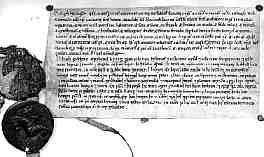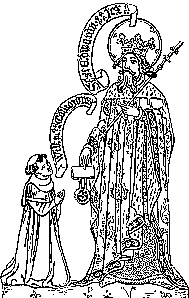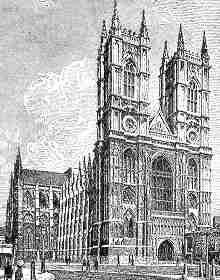 |
|
Forged
Charters (2) |
|
So
how good were these forgeries, and how easy is it to tell whether a charter
has been forged? The fact that quite a number are still in dispute indicates
that it is not always clear, and this partly relates to a certain variability
in the format during this period when the whole process of written administration
was still under development. What can also cloud the issue is that at
least some of the time, monasteries wrote out, and possibly even drafted
the wording of genuine charters, which were then presented to the monarch
for ratification with the great
seal. The distinction between forged and genuine charters blurs when
the distinction is between drafting a document retrospectively and drafting
one for the present. |
 |
Charter
of Henry I (British Library, Campbell Chart. xxi 6), by permission of the
British Library. |
| This charter is a notification that the king has confirmed to the monastery of Christ Church, Canterbury the lands that they held in the time of Edward the Confessor and William I. |
|
The
charter, or writ,
shown above has been illustrated and discussed in several books. It is
believed to be genuine, although it has a number of unusual features.
The script is not
the chancery
hand of the period, but a form of book
hand, indicating that it was most likely written in the recipient
monastery. The text is written twice, in Latin and Old
English, and has a pretty comprehensive list of rights and privileges
spelled out in the text. There is no list of witnesses. The great seal
is thought to be genuine, although it is attached in an unusual way to
the side of the document. It probably represents the sort of co-operative
arrangement between grantor and grantee that made the forging of charters
not so difficult an operation. |
|
There
are various clues which can suggest the authenticity or otherwise with
varying degrees of authority. The producers of forged documents were sometimes
a tad careless with the witness lists, so that the listed testators could
not possibly have been occupying the positions that are ascribed to them
at the same time. There are certain formulae within the document that
changed over time, such as the title of the monarch. Willelmus
rex Anglorum is the usual for William I and II; Willelmus
rex Anglie is a later anachronism, Willelmus
Dei gratia rex Anglorum is dubious. Such criteria can only be applied
to original documents. In cartulary
copies, the scribe
may simply have mistranscribed a formula into the contemporary mode. Detecting
a forgery through dating the handwriting is a dodgy proposition. If an
original charter of William I is written in protogothic
script, that is clearly incorrect, but there were scribes who could turn
out oldfashioned scripts should the occasion require it. |
|
Sketch from a 15th century stained glass window in Great Malvern church, Worcestershire. |
|
The
significance of possessing an ancient charter is shown in the above illustration,
which commemorates the grant of Edward the Confessor to the church. Note the
charter, with seal attached, dangling from his hand. |
|
The
forged Battle Abbey charter shown on the previous page is somewhat peculiar
in its diplomatic,
being a hybrid between a solemn diploma
of the antique kind and an Anglo-Norman writ. However, this was not considered
too strange for the time. The script is a perfectly acceptable English
Caroline
minuscule that could readily pass for an 11th century hand. |
 |
The title of the king from the Battle Abbey charter (British Library, Egerton Charter 2211), by permission of the British Library. |
|
One clue is that it seems a dei
gratia has sneaked in there. |
|
This
particular charter falls down on a number of grounds, including its Latin
grammar, the fact that certain information which should be there is missing
and because the foundation charter of the abbey had never been publicly displayed
before 1157. In addition, a seriously telling flaw is that the great seal
is a rather bad forgery. |
|
Something
in this whole process suggests that there has been a shift in the cultural
meaning of the great seal between the time of its introduction and the
time that the forgeries were produced. A careful examination of seals
has indicated to scholars that a number of abbeys in different areas of
the country, including Westminster, Battle, Coventry, Gloucester and Ramsey
sealed their forged charters with seals that were made from the same forged
matrix and the same red wax. Either there was an itinerant seal forger
doing the rounds, or one of the abbeys was acting as a centre of production
of forged charters. Close examination of the documents has suggested to
scholars that the forgeries may have been produced in no less a place
than Westminster Abbey; foundation, burial place and shrine of Edward
the Confessor himself. |
|
|
Westminster
Abbey, royal foundation and possible centre of document forgery. |
|
At
the time of Edward the Confessor, the great seal was an object that substituted
for the actual presence of the king on the occasion of an oral proclamation
of a charter. One might assume that nobody would regard lightly the false
manufacture of such a significant item. By the 12th century they were churning
them out in a process of retrospective tidying up of the records. The seal
must have become a much less powerful presence in its own right. It was merely
an instrument of authentication of the written words of the charter; a sort
of very fancy rubber stamp. |
|
 previous page
previous page |
 Categories
of Documents Categories
of Documents |
|
 |
 |
 |
 |
 |



